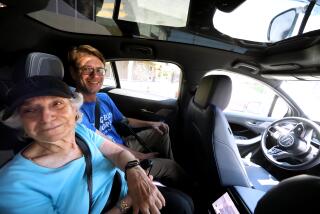GM buys Cruise Automation in a bid for autonomous driving
As it plunged toward bankruptcy in 2009, General Motors Co. was slammed for its reluctance to change.
Now, with the auto industry speeding toward a point where cars drive themselves, the automaker is trying to get ahead of the curve.
On Friday, GM said it acquired Cruise Automation, a 40-person software company in San Francisco that has been developing autonomous-vehicle technology.
GM plans to use Cruise technology to gave autonomous capability to its vehicles, though probably not in existing models.
The company has not yet announced when Cruise’s technology will be integrated into GM vehicles, only that it will be “as soon as possible,” said Kevin Kelly, a GM spokesman.
The deal marks Detroit’s latest foray into Silicon Valley.
Also Friday, Ford Motor Co. announced the creation of Ford Smart Mobility, a subsidiary focused on designing, building and investing in such things as connected vehicles and autonomous technology.
Two months ago, GM bought the assets of Sidecar Technologies Inc., a San Francisco ride-hailing company, and invested $500 million in the ride-sharing service Lyft. GM and Lyft plan to collaborate on a service that will allow users to reserve a self-driving car.
Founded in 2013, Cruise Automation is best known for its software that gave autopilot capabilities to conventional cars, said Kyle Vogt, company founder and chief executive. About a year and a half ago, the company switched its focus to fully driverless technology.
Cruise said it is one of the few firms that has a permit from the California Department of Motor Vehicles to test self-driving vehicles on public roads.
“We share a common vision with GM for how autonomous vehicles will change the world,” Vogt said. “We were already on that path, and we remain on the path.”
Financial terms of the deal were not disclosed, and Vogt and Kelly said they would not comment on “speculation” about the price tag. ReCode and Fortune quoted anonymous sources as saying the price was at least $1 billion.
GM said Cruise would continue to operate in San Francisco, but would function as an independent unit within the automaker’s newly formed autonomous-vehicle development team.
“Cruise provides our company with a unique technology advantage that is unmatched in our industry,” Mark Reuss, GM executive vice president, said in a statement. “We intend to invest significantly to further grow the talent base and capabilities already established by the Cruise team.”
The Sidecar and Lyft investments — and GM’s launch in January of the Maven car-sharing service, which allows users to reserve and unlock vehicles with their smartphone — indicate that the company wants to quickly integrate new technology.
“GM is actually investing in products that are already developed, so they’re not inventing from scratch,” said Rebecca Lindland, a senior analyst at Kelley Blue Book. “It makes sense, saves money and also potentially speeds up the adoption rate and the technology and integration.”
Technology is now the biggest difference between vehicles because their quality, durability and reliability are more or less on par, said Ed Kim, vice president of industry analysis at market research firm AutoPacific.
The best example of a seamless blend between technology and autos is Tesla Motors Inc., he said.
“Elsewhere in the automotive industry, you’ve got automakers trying to interact with tech companies, but Tesla is, by its very nature, both,” Kim said. “It’s certainly a driving force in getting the traditional automakers really thinking about the future and … how technology fits into the future of the automobile.”
That future poses a threat to the traditional carmakers’ sales models.
“As autonomous vehicles become more and more widespread, especially in urban areas … we’re looking at a potential future where car ownership may decrease,” Kim said. “This does have some very big potential and far-reaching implications in the sense that this will definitely have an impact on future auto sales volumes.”
GM and Ford have been ramping up their presence in Silicon Valley.
Ford said its new Smart Mobility subsidiary will function as a start-up and will have operations in Palo Alto and Dearborn, Mich.
In January 2015, the carmaker opened a research center in Palo Alto dedicated to advanced automotive technologies, such as autonomous and remotely piloted vehicles.
In December, Ford received a permit to begin operating a driverless car on public streets.
Compared with Ford and GM’s tepid interest in alternative energy vehicle development in the 2000s, this time seems different, said Jessica Caldwell, a senior analyst at Edmunds.com.
“There’s more visibility in this issue,” she said. “All of this is very buzz worthy, where if you made a push toward improving fuel efficiency … it wasn’t really as interesting back in 2007. I do think they’re being more proactive with this issue.”
Twitter: @smasunaga
More to Read
Inside the business of entertainment
The Wide Shot brings you news, analysis and insights on everything from streaming wars to production — and what it all means for the future.
You may occasionally receive promotional content from the Los Angeles Times.











